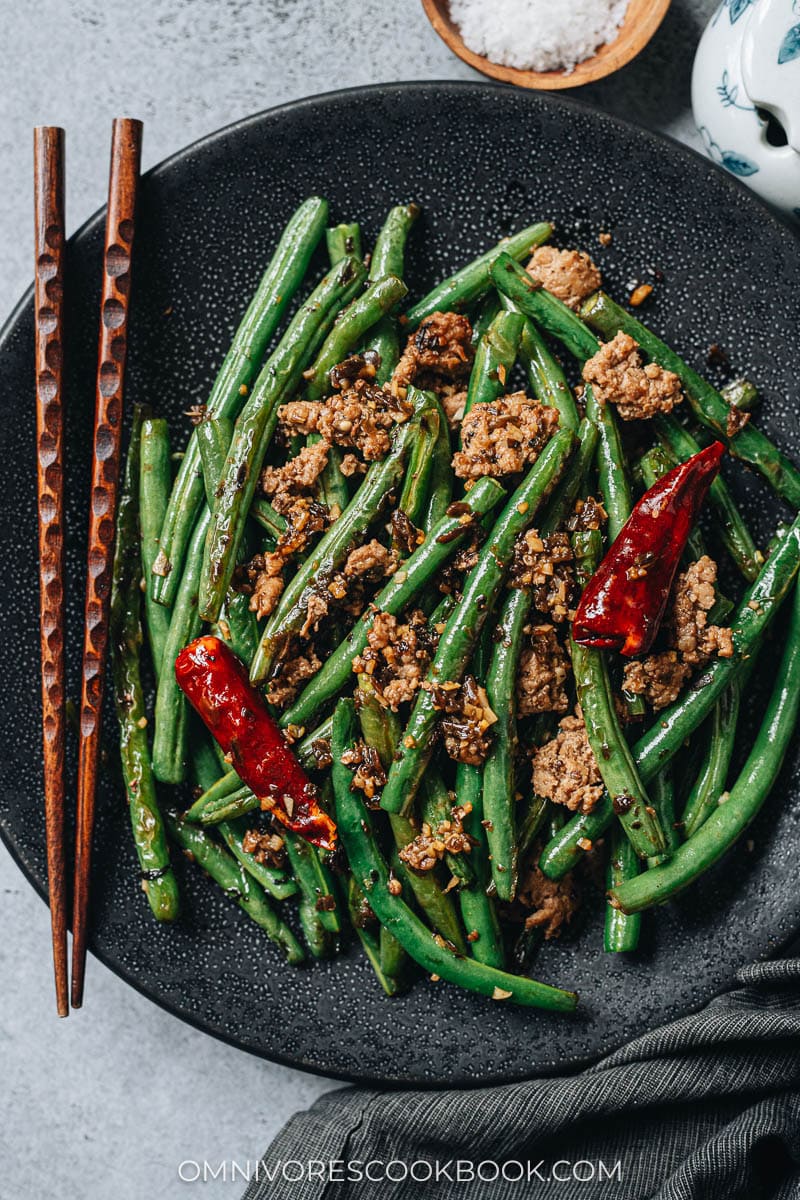
Sichuan dry fried green beans, or Gan Bian Si Ji Dou (干煸四季豆), is a famous traditional Sichuan dish. The fresh green beans are roasted in a pan until blistered and beautifully charred, then tossed with ground pork, pickled mustard greens, ginger, garlic, chili peppers, Sichuan peppercorns, soy sauce, and wine for a rich and fragrant taste.
It is one of my favorite ways to cook green beans because it gives them a heavenly texture and a rich taste that goes so well with rice, and in my opinion, it also works fantastic as a side for Asian Thanksgiving recipes including my juicy slow roasted turkey legs.
When I would host foreign colleagues and friends back in China, I took countless people to experience real Sichuan food. The Mala Chicken and Dan Dan Noodles might be the most famous ones. But at the end of the day, vegetable dishes like these dry fried green beans and Sichuan Eggplant always won everybody over and became their new favorite Chinese vegetable stir fry recipes.
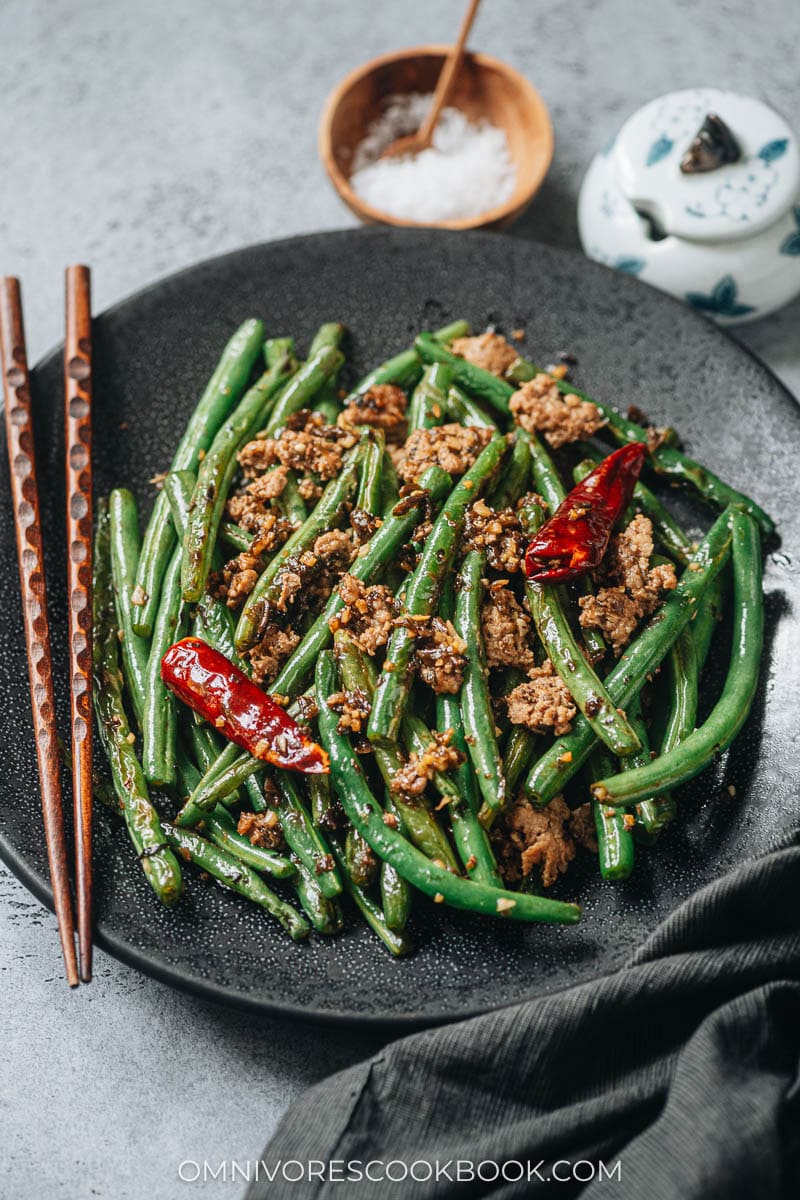
Dry fried green beans ingredients
Sui Mi Ya Cai
Sui Mi Ya Cai (碎米芽菜), or Sichuan Sichuan fermented pickled mustard greens, is the secret ingredient that makes this dish very authentic.
The mustard greens are hand pickled, sliced, and dried. Then they are seasoned with salt and packed into ceramic pots to ferment for three to six months. After the first fermentation, they are boiled with brown sugar for eight to nine hours and then hung out to dry once more. In the final stage, these greens are sealed again with star anise, Sichuan peppercorns, and other spices, for another three to six months.
The ingredient adds sweetness and a super umami to a dish to make it irresistible.
You can find Sui Mi Ya Cai at most Chinese markets and online.
If you have Sui Mi Ya Cai, it’s very easy to turn dry fried green beans into a vegan / vegetarian dish without compromising on flavor.
However, if you do not have this ingredient, I highly recommend adding ground meat to the dish to boost the flavor.
Mise en place
When you’re ready to cook, your table should have:
- Prepped green beans
- Ground meat
- Aromatics (ginger, garlic, dried chili pepper)
- Ground Sichuan peppercorns
- Sui Mi Ya Cai
- Seasonings (Shaoxing wine, soy sauce and sugar)
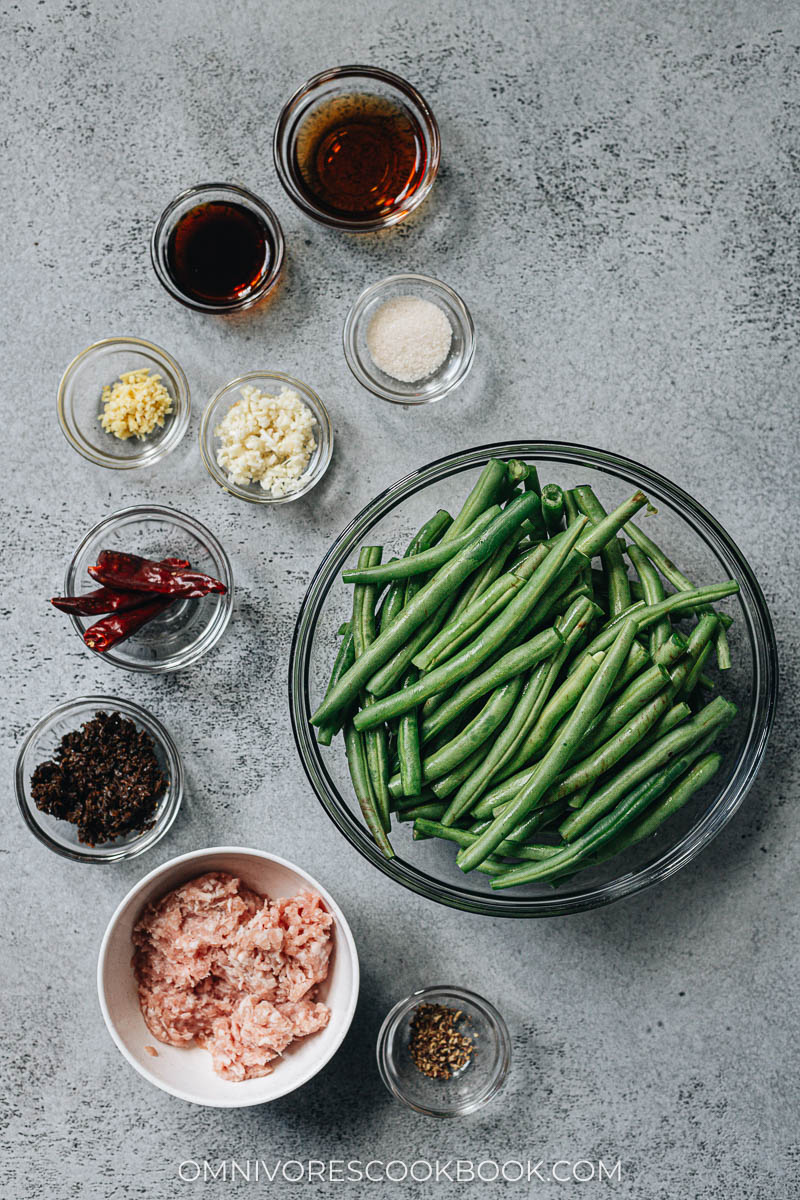
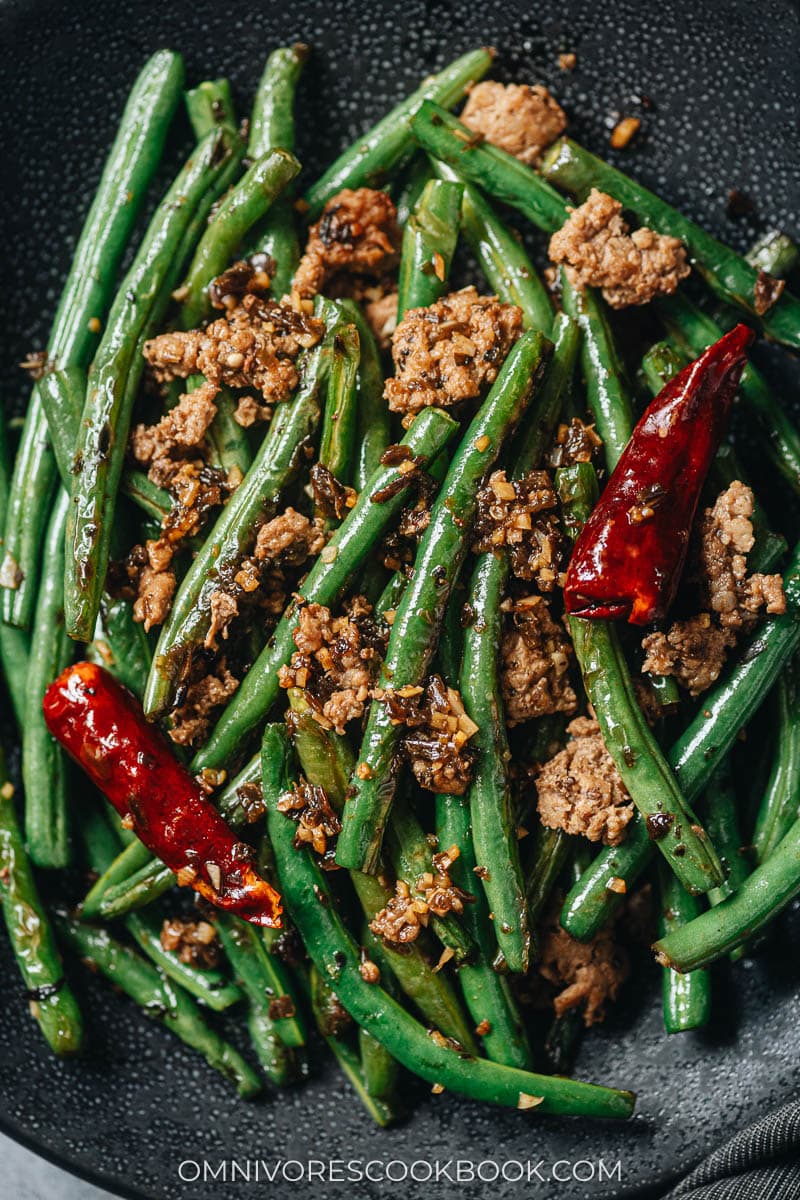
Ground pork is often used in this dish, but I’ve tried it with ground chicken, turkey and beef. They all work really well.
How to cook dry fried green beans
- Pan fry the green beans
- Take out the green beans once they are blistered and just turning tender
- Cook the ground meat, with Sichuan peppercorns and Sui Mi Ya Cai
- Add the aromatics
- Return the cooked green beans to the pan
- Add the rest of the seasonings and stir everything together
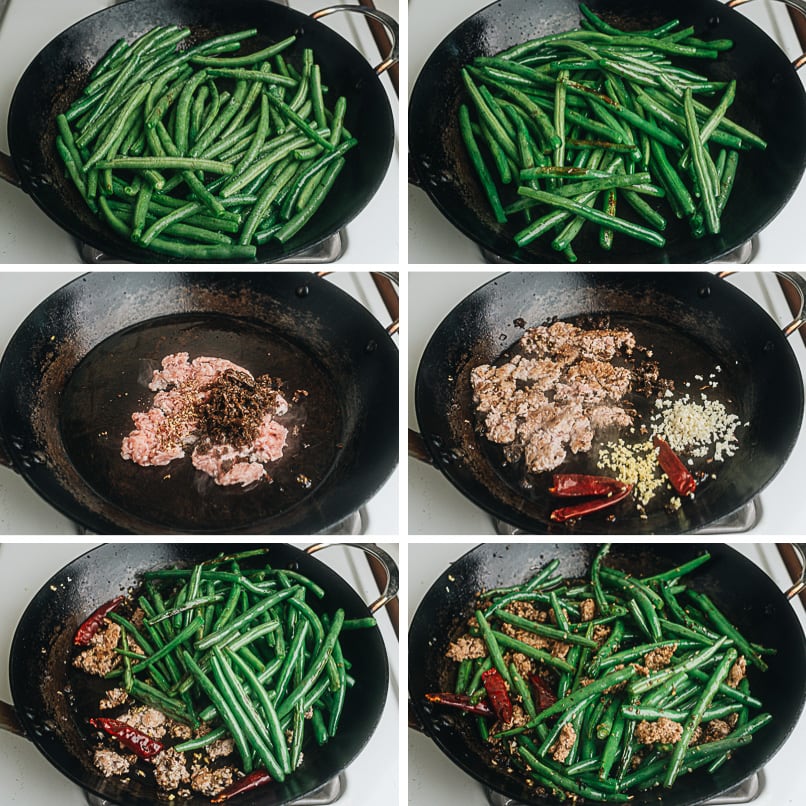
What is dry frying?
Dry frying, or Gan Bian (干煸), is a Chinese cooking technique. It is somewhere between pan searing and deep frying. But it uses less oil, with a longer cooking time, to cook vegetables or meat to slightly dehydrate them, thus creating a crispy and charred surface. The texture of dry-fried vegetables is similar to that of grilled ones, with a hint of smoky flavor.
Seasonings are added after dry-frying; in this recipe, soy sauce, dried chili peppers, and Szechuan peppercorns are used. The withered surface of the green beans holds the spices well, making for an appetizing, intense, and pungent flavor without using a ton of sauce.
How do I make this dish vegetarian / vegan?
The authentic version always uses ground pork as a way to enhance the flavor of the veggies. For a vegetarian alternative, you can choose from minced rehydrated dried shiitake mushrooms, a bit more Sichuan pickled mustard greens, a spoonful of fermented black beans, or some fermented spicy bean paste (the dish will be slightly spicy).
Do I need to use a wok?
Yes and no.
In fact, the first part of the cooking, pan roasting the green beans, works better in a skillet than a wok. It provides a larger contact surface and the beans will be cooked more evenly.
Normally, the second part of the cooking is done in a wok, where you toss the green beans with pork and the rest of the spices. However, I’ve done various experiments and discovered that you can create great results using a skillet, as well. I highly recommend you stay with the skillet, especially if you have an electric stove. For more information, check out why you should stir fry with a frying pan instead of a wok.
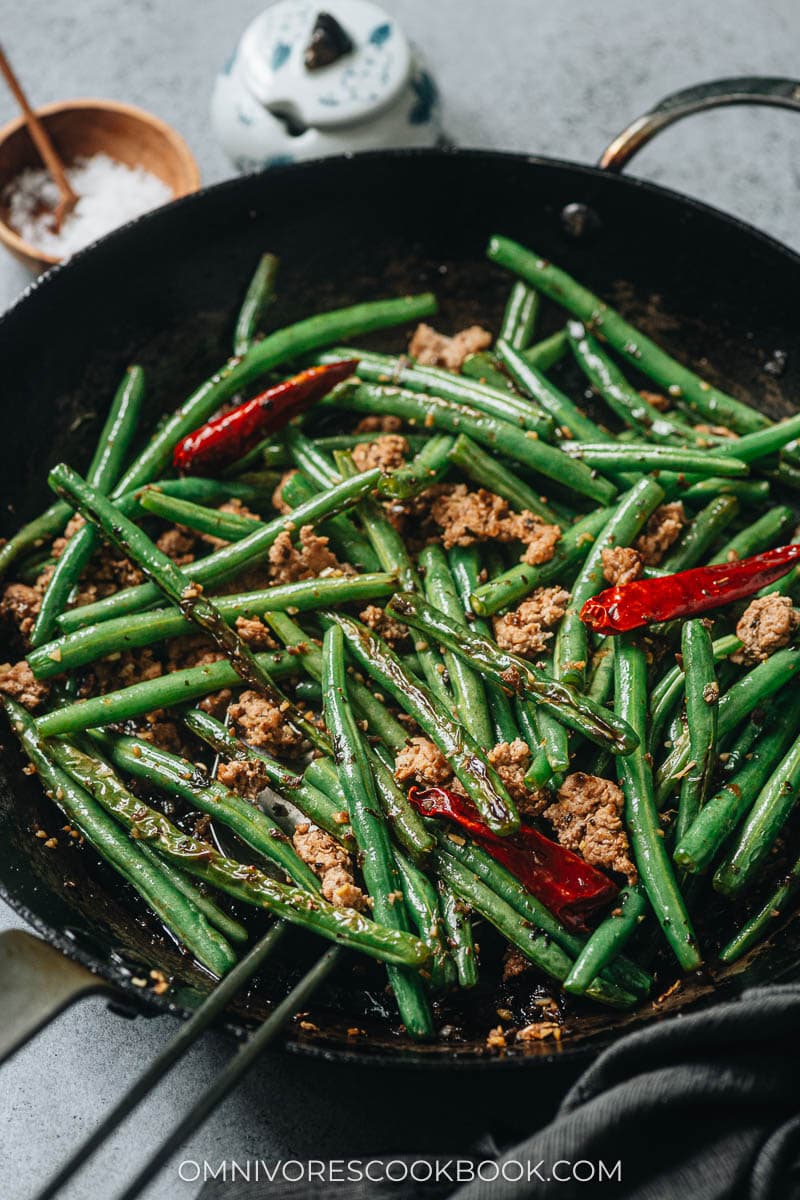
Other delicious Sichuan recipes
- Sichuan Eggplant Stir Fry (鱼香茄子)
- Authentic Mapo Tofu (麻婆豆腐)
- Kung Pao Shrimp (宫爆虾球)
- Chinese Potato Stir Fry (炝炒土豆丝)
- Sichuan Spicy Wonton in Chili Oil (红油抄手)
- Shredded Pork with Garlic Sauce (鱼香肉丝, Yu Xiang Rou Si)
Chinese Cooking Made Easy
Are you new to this website? This free email series is a great place to start. I’ll walk you through a few of my most popular recipes and show you how and why they work. You’ll quickly start to cook better Chinese food in your own kitchen.
Watch video
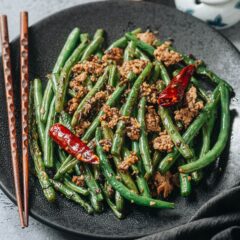
Sichuan Dry Fried Green Beans (干煸四季豆)
Ingredients
- 1 lb green beans , tough ends removed
- 2 tablespoons peanut oil (or vegetable oil)
- 4 oz ground pork (Optional but highly recommended) (*Footnote 1)
- 2 tablespoons Sichuan pickled mustard greens (Sui Mi Ya Cai) (*Footnote 2) (Optional)
- 1/4 teaspoon ground Sichuan peppercorn
- 3 dried chili peppers (*Footnote 3)
- 3 cloves garlic , minced
- 1 teaspoon minced ginger
- 2 tablespoons Shaoxing wine (or dry sherry)
- 1 tablespoon light soy sauce (or soy sauce)
- 1 teaspoon sugar
- Salt to taste
Instructions
- Pat the green beans dry with paper towels to prevent them from splattering.
- Heat 2 tablespoons vegetable oil in a large nonstick skillet over medium-high heat until hot. Add the green beans and a pinch of salt. Stir to coat well with oil. Spread the beans to prevent them from overlapping, as much as possible. Flip every 15 seconds or so. Cook and stir until some of the surface is brown and withered, and the green beans just start to turn soft, 6 to 8 minutes. If you prefer a softer texture, wait until most of the surfaces have charred, 10 to 12 minutes. Turn to medium heat if the pan starts to smoke too much. Transfer the green beans to a plate and set aside.
- Add the remaining 1 tablespoon oil, ground pork, pickled mustard greens, and the ground Sichuan peppercorns. Cook and chop the pork to separate it into small pieces, while mixing with the rest of the ingredients.
- When the surface of the pork has cooked, add the dried chili pepper, garlic, and ginger. Stir a few seconds to release the fragrance. Add back the green beans. Swirl in the Shaoxing wine, light soy sauce, and sugar. Cook and stir until the sauce is mostly absorbed, about 1 to 2 minutes.
- Turn to low heat and carefully taste a green bean with some pork. Adjust seasoning by adding more salt, if needed. Transfer everything to a plate. Serve hot as a side dish or one of the main dishes of a multi-course meal.
Notes
- The purpose of ground pork is to add flavor and texture. It helps a lot, especially when you don’t use the Sui Mi Ya Cai (pickled mustard). You can also use ground chicken or ground beef instead of pork.
If you choose to skip the ground meat, I highly recommend adding Sichuan pickled mustard greens to enhance the flavor. If you do not have Sichuan pickled mustard greens, adding a bit of chicken bouillon, or 2 tablespoons of fermented black beans, or 1 tablespoon of fermented chili bean paste (Doubanjiang) will help develop the flavor too. - Sichuan pickled mustard greens add savory and sweetness to the dish, making it extra rich. If you do not have pickled mustard greens, 2 tablespoons of fermented black beans, or 1 tablespoon of fermented chili bean paste (Doubanjiang) will work great, too.
- The dried chili peppers add a fragrance and smokiness to the dish but not much in terms of heat. If you want the dish to be a bit spicy, break apart the chili peppers before adding them.
Nutrition

Did you make this recipe?
I’d love to hear how it turned out for you! Please take a moment to leave a 5-star rating ⭐️ and share your thoughts in the comments further down the page. It really helps others discover the recipe too.

Tanzeela
Replaced the pork with mushrooms, and this was delicious! I’ve never had a successful green bean recipe until I tried this one. Green beans were the perfect texture and absorbed the sichuan flavor well. Finally have a staple green bean recipe.
Lucy
This is the best recipe I’ve tried for this dish! And I’ve tried a lot of them. Looking forward to trying your other recipes.
Reed
Wonderful, adaptable recipe. I couldn’t find the pickled mustard greens or the Szechuan peppercorns in my local Asian store (it’s mostly Korean foodstuffs), and I wanted to make a vegetarian version with tofu. The dry fry was a new technique for me and I loved how it turned out. I used a steel pan instead of a wok and added some extra sherry and some Korean fermented pepper paste (Gochujang) to liven it up. I added the ginger and garlic after dry frying the green beans, then I added the sauce, and finally the tofu (I made sure to press the tofu in a towel for a couple of hours before, to get rid of the water). Everything came out so flavorful and delicious, will definitely be making this one again.
Sam Yuen
I am looking forward to making this dish! It’s one of my favourites. Can I use chili radish 蘿蔔 instead of pickled mustard greens?
Maggie
Hi Sam, I’m not sure which type of chili radish you have, but you can simply skip the pickled mustard greens if you don’t have them. It’s a very special type of pickle that has a distinct taste (savory and sweet). Normally the other type of spicy sour pickle won’t work as a substitute. If your chili radish is more on the savory salty side, you can use a bit to enhance the flavor of the dish. Otherwise I recommend simply skipping it.
Happy cooking and let me know how the dish turns out!
Diana
I am planning a dinner party with a few of your wonderful recipes, but do not want to be in the kitchen cooking while the guests are mingling. Is there a way to keep the dishes (Sichuan green beans, dumplings, etc) hot in the oven or do you think that is a bad idea?
Sarah
THANK YOU for this recipe!! I lived as an expat in China for 5 years and even took some informal cooking lessons from several 阿姨 but basically failed to grasp good cooking because so much of it is a feeling. I have looked for a long time to find a recipe like this with very detailed and specific (Western-er friendly! lol) instructions. I have been craving this dish and although my first attempt could use some improvement (and better ingredient sourcing!) it was very close to 地道的菜!
Maggie
Hi Sarah, I’m glad to hear you like the recipe! I totally feel you. I had some trouble learning from my mom and grandma, because apparently no ones write down recipes or provide any measurement lol Leave a message anything if you need help and I hope you can find all the ingredients to make your favorite dishes 🙂
Have a great day!
Kevin
Hi Maggie, I commented on your amazing black bean sauce, the BEST recipe, period!!!
So I’m on the net looking for a good twice cooked pork recipe, and wound up here, again!! The pork recipe linked me to ANOTHER recipe, this one for dry fried green beans, which caught my eye as it’s one of my favorite dishes I never seemed to get quite right over the years. I made it tonight served as a side to my Kung Pao Chicken.
This is now my go-to DFGB recipe!! Maggie, you are absolutely amazing!! I followed this recipe to a T, even ordered the mustard greens from Mala Market (I like my dishes authentic!). This was mind blowing good! I have never had, or made, dry fried green beans this savory, with this depth of flavor, ever. Anywhere. Easy and incredibly delicious.
After so many failures, once again, it’s Maggie Tsu selflessly sharing her recipes with all whom will seek and prepare them, which provided me the golden ticket for the best DFGB recipe ever!
My eternal thanks for this site, you have some serious culinary Kung Fu, don’t stop sharing, and I need to catch up!
P.S. Have you considered putting out a hard-copy cookbook, market on Amazon or wherever you like? I’d be the first in line to buy it and first in line to get it signed. :). Your recipes have been a clear cut above the rest. Please consider it, I want one! :).
Deborah Jayne
Tried this today and it turned out really well! Nice to have less oily green beans than we get when we eat out!
Maggie
Thanks so much for taking time and leaving a comment Deborah! I’m glad to hear the recipe worked for you 🙂
Lisa medina
Hi Maggie made this dish using exact ingredients . Super easy and delish, love ur recipes and ur blogs .
Harry Rutgers
I’ve made the recipe only to substitute the pork for chicken thighs and doubanjiang with Fermented black beans. It tasted like heaven! An absolute 5 star dinner, Thank you so much for sharing!!
Maggie
I’m so glad to hear you enjoyed the dish Harry! Using chicken thighs sound so good and healthy! I’d love to try it out next time 🙂
Lori Lippitz
Lori reporting back: Sorry no photo, but I’d love to have your input. What worked: The pickled mustard and chopped dried black beans worked great! Added texture, flavor and salt. Everyone ate them up–all two pounds of beans! Things that didn’t work as well: I couldn’t get enough of the beans to blister fast enough, so they got slightly overdone I was using a cast iron Dutch oven. Do I need to buy a cast iron wok?
Maggie
Hi Lori, I’m glad to hear that everybody loved the green beans!
To answer your question, I think the best way is to cook the green beans in smaller batches. I usually use my 11-inch heavy duty skillet to pan fry the beans. It holds one pound at a time. What I do is to use medium high heat to heat the oil to really hot, then turn to medium heat to roast the beans. I only stir and flip them every minute or so, and I do remove some of the beans that are already blistered so the rest will cook faster. If you’re cooking two pounds beans, you probably need to separate them to 2 to 3 batches, depends on the size of your pan. I wouldn’t suggest a cast iron wok for this task unless you want to use more oil to deep fry the beans (which is also an authentic way to cook the dish, but I rarely use at home).
Lori Lippitz
This is my favorite dish of my favorite cuisine! I will cook it tomorrow night for visiting students from Pakistan–I hope they like it. I am a vegetarian, so I am pondering about what to substitute for the pork. (When I order it in restaurants, I always ask for it without pork, and it always tastes great, so I might just go without.) But what do you think about some finely minced Chinese salted black beans? Or is that not the flavor you would be going for?
I could also just use finely chopped and fried Mock Duck, which comes in a can and is excellent. Your suggestions would be appreciated! And thank you for a clear, simple approach that does not promote any products. What a relief!
Maggie
Hi Lori, you can definitely turn this dish into a vegetarian one by simply skipping the pork. I love the idea of adding minced black beans and I use the method sometimes too! If you have Sui Mi Ya Cai (Sichuan pickled mustard), you can use it to replace the pork as well. In fact, many authentic Sichuan dishes use this pickle to cook with or without the pork. The mock duck should work too, but you probably want to chop them really fine. I’d still add some black beans or the pickles even if I use the mock duck because it adds more texture than flavor. Sounds like you’re an expert of Chinese cooking already, so I believe the dish will turn out great in any case 🙂
Happy cooking and hope your students enjoy it!
Lori Lippitz
I do have some pickled mustard, weirdly! I’ll try that and tell you how it goes. I am far from an expert at Chinese cooking, but it is my favorite cuisine and I am always trying to learn. But I will not be putting Great Beijing Restaurant out of business anytime soon!
Maggie
You have such a well-stocked pantry Lori 🙂 I can’t wait to hear your feedback on the vegetarian version. Happy cooking and have a fantastic weekend!
Kathy Beatty
HI Maggie,
I just discovered your wonderful website. Everything looks so delicious and the way you break down the steps and give extra tips, it makes all of them look very doable. I cannot wait to try out your recipes!
KB
Maggie
Thanks for taking time to leave a comment Kathy! I’m glad you found my blog too 🙂
Can’t wait to hear how your dishes turn out. Happy cooking and have a great week ahead!
marina yee
I tried this last night , My family loved it. I minced up the chilli and also left the sichuan peepers in the dish. Just Delish!
Thanks
Maggie
So glad you tried my recipe and like it Marina! Mince up the chili is a great idea! It definitely spice up the dish a bit more, just the way I like it 🙂
Hope you have a great weekend!
Judi
I used around 10 sichaun pepper corns in with the beans, and left them in, love the lemony flavour they impart to the final dish. Added a little more soy and shaoxing for flavour at the end, was very like the dish we love in our local Sichaun restaurant. Thanks for the recipe
Dave
Thanks for the recipe! How would I adjust it to make it “ma la”? How much red and Sichuanese pepper should I add and where? Pretty much every place I ate this in Beijing cooked it with the numb/spicy effect.
Thanks!!
Maggie
Hi Dave, I have used some red chili pepper and Sichuan peppercorns in this recipe. You can find them on step 5 (where you infuse the hot oil with the ma la flavor, but remove the peppercorn to avoid biting into them later). I personally would cook it with a teaspoon Sichuan peppercorns and 3 to 4 pieces chili pepper.
In step 5, Add the peppercorns into the oil first and cook over medium low heat until their color turns dark. It will take a minute or two. And then add chili pepper can continue cooking. If you do not mind having the peppercorns in the dish while eating (just like what we do in China), do not remove them and you’ll get more of the “ma” flavor. Also make sure you select the good Sichuan peppercorns. If you cannot smell the numbing flavor when you open the bag, the peppercorns are probably being pasteurized and do not have the numbing flavor.
I always break the chili pepper to reveal the seeds, so the dish will be spicer. Again, it depends on the type of chili pepper you use. If you got the really spicy ones, 2 will make a dish very spicy.
I hope this is helpful! Let me know if you have any other questions and hope the dish turns out great! 🙂
Michelle @ Vitamin Sunshine
Looks delicious! I always order green beans with garlic when I go out for Chinese– I am going to have to see if I can recreate it at home with your recipe.
Joni Renee Zalk
This recipe looks great, though I’ll have to convert the recipe to pounds instead of ounces or grams. I’m surprised that there is no hoisin sauce. Yummy!!
Maggie
Hi Joni, I’m so glad you like this one! This is a Szechuan dish and hoisin sauce is not a common ingredient in the cooking. Instead we use soy sauce. Hope you enjoy the dish and happy cooking! 🙂
Claire
Maggie, thank you so much for this recipe! I have always loved this dish in restaurants and never really thought about making it for myself. My family loved the result and we make this at least once a month now.
I made a few alterations to suit me: a vegetarian recipe with vegetable stock and no pork, plus I leave out the salt. I am amazed by the flavor 🙂 I love your blog!
Maggie
Hi Claire, thanks for the comment and I’m so glad you like my recipe! Believe or not, you just made my day 🙂
I never thought to use vegetable stock to make this one, what a great idea! Will definitely try out the vegetarian version next time. Thanks for sharing the tips and hope you have a great day ahead 🙂
Leyla
Yummy thanks for the step-by-step pictures for this dish, they really helped! I kept it simple, after I dry fried the beans I took the excess oil out and then fried some garlic until fragrant, afterwards I added the green beans back in, added a pinch of salt and some oyster sauce and later some sugar when I realized WOW salty. It came out really tasty though.
Maggie
Thanks for trying out my recipe! 🙂
Oyster sauce + sugar sounds very yummy and I believe it tastes good with rice. Dry fried vegetables absorb flavor easily, so be careful when you add salty ingredients such as soy sauce and oyster sauce.
I will try to cook with oyster sauce next time for sure! 🙂
Peekaboo
Hahaha. That is like looking at a recipe for pizza and making a plain flatbread instead.